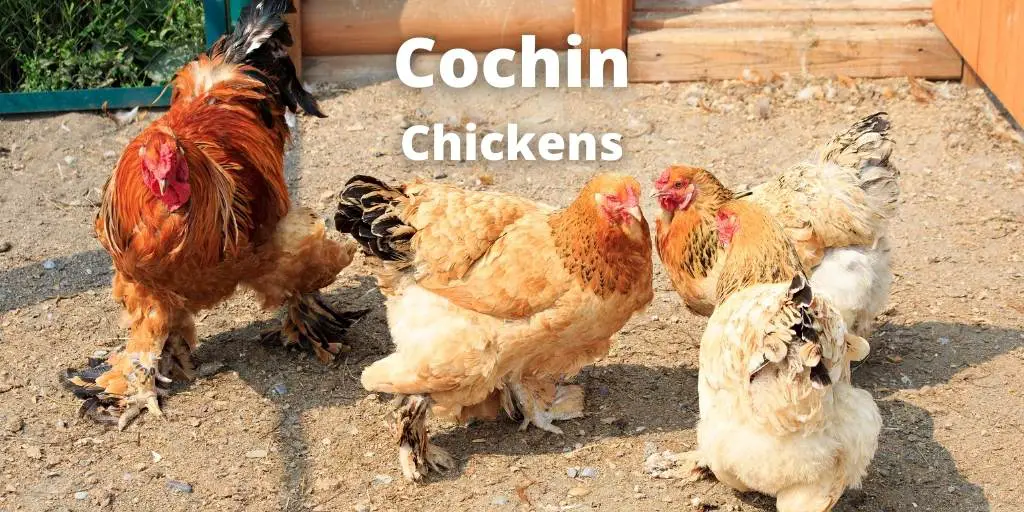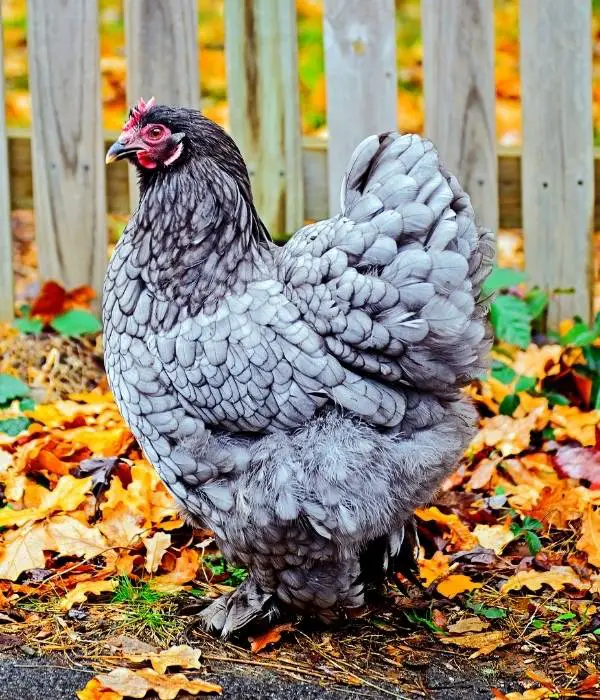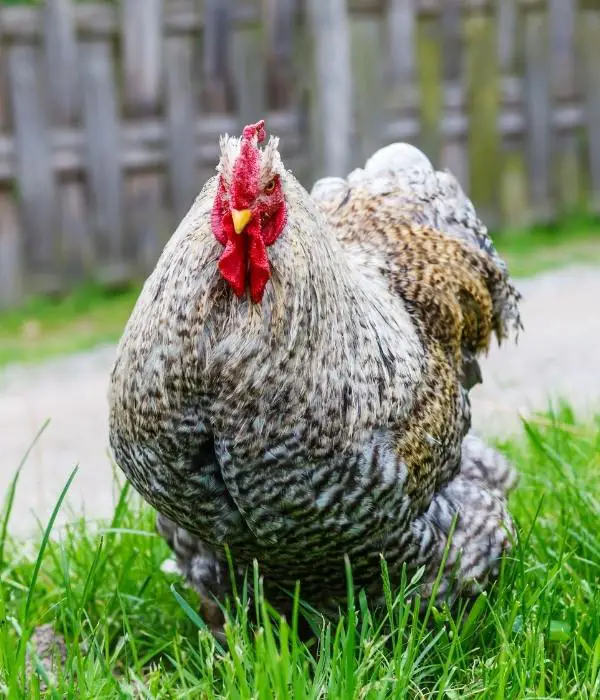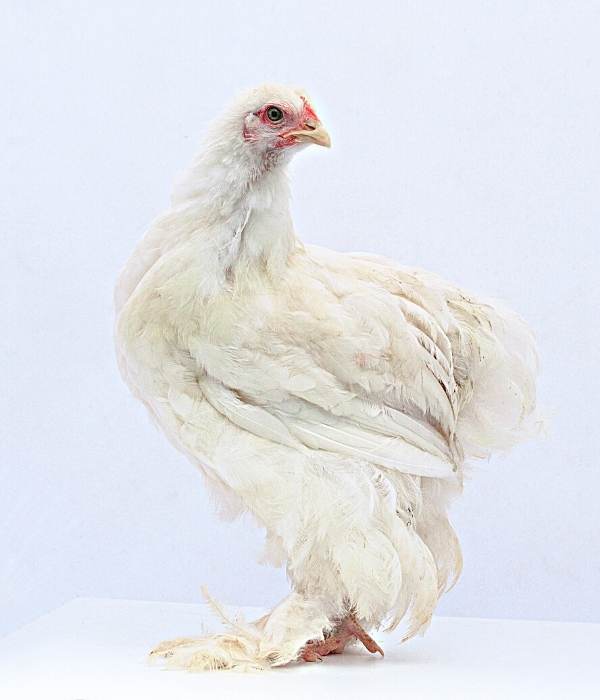
The Cochin chicken is a popular breed with backyard chicken keepers and enthusiasts. It is usually fluffy and big in size. They are docile, friendly, and lovely pet chickens.
Cochins are not widely known for laying eggs; however, they serve as beautiful broody hens and can sit on them all day.
It is for sure that this fluffy chicken will catch your attention. If so, keep reading to know everything about this feathery Cochin chicken of the barnyard.
This article includes primary information like history, lifespan, recognized verities, size, eggs, color, care, images, and more about Cochin chicken.
Also read: Top 10 Best Rooster Breeds
What is Cochin Chicken?

Cochin chicken is one of the most cuddly and lovable poultry. This chicken breed is a happy and friendly chicken. If you keep it as a house pet, it will give you a few eggs every week.
Here is the guide to read about the best chickens that lay many eggs. (Best Egg Laying Chicken Breeds)
The Cochins that we know today started its journey in the Victorian age. It was a tall bird selectively bred with enthusiasm by the breeders. This chicken has become one of the most preferred backyard chickens today.
It is a good and dedicated broody chicken that will raise some chicks for you. You will find it peacefully walking in the yard and searching for food items. Cochin chickens like to eat a lot.
History of Cochin Chicken
The Cochin chicken first came into the limelight in the 1840s. Initially, they were called ‘Cochins-China.’ They were initially imported from the French colony of Vietnam. They were its native, but not after the Chinese.
The original ‘Cochins’ were not similar to those that we found today. They were similar to the Jungle Fowl or Malays. Initially, they looked tall and rangy, but they didn’t were beautiful.
Once, Queen Victoria received a Cochin chicken from Captain Edward Belcher. Those chickens were crossbred with other breeds from China and Europe to obtain a need to breed.
Cochin Chicken Lifespan
Cochins have a reasonable life expectancy compared to other large-size chicken breeds. The Cochin chicken has a lifespan of about 8-10 years.
Recognized Varieties & Continental Breeds of Cochin Chicken

The Cochin chicken was recognized by the British Poultry Standard in the year 1865. In the same year, the first edition of the standard was issued.
The American Poultry Association standard was issued in 1874. In both countries, it is classified as one of the Asian classes – the other breeds are Brahma (from Shanghai) and Langshan (from China).
They are available in both standard and bantam Cochin varieties. In England, the Cochin chicken bantams are not very popular. They are classified as Pekin bantams.
The acceptable color of this breed varies from the US to the UK. The following colors are found in the UK:
- Black
- Buff
- Blue
- Cuckoo
- Partridge
- White
The American Poultry Association recognizes nine colors for the standard-size Cochins:
- Barred
- Black
- Blue
- Brown
- Buff
- Golden-laced
- Partridge
- Silver-laced, and
- White
The APA accepts the same color for the bantam-size Cochins also.
Egg Production

Cochins are not bought to lay eggs. They are moderate layers and lay about 2-3 medium-sized brown eggs weekly. It’s not a dual-purpose chicken.
This comes out to be about 150 to 180 eggs per year. Cochins take a longer to grow, and they can’t lay eggs until they are 8 months old.
- They usually lay medium-sized brown eggs.
- They lay about 150-180 eggs annually.
Also read: Chickens that lay colored eggs
Temperament
They are friendly and docile and are very good as mothers. Cochin chicken is a kid-friendly chicken breed.
The Cochin rooster and hens are calm, friendly, and mellow birds. Hens are not at all aggressive, so they are best for all newbie chicken raisers.
The bantam roosters are not so mellow and are found to be feisty and aggressive in fighting for territory.
You will love the broodiness of Cochin moms. They happily sit on eggs once they come in the form.
So, you can easily raise them for breeding moms for eggs and chicks. However, this depends on the brooding time of the individual birds.
Cochins are poor flyers because of their heavy-weight body. So, you can easily keep Cochin chickens in a two-foot fence.
They love confinement and free-ranging, but if kept inside, they become lazy and sit mostly near the chicken feeder.
Color, Size, Appearance, Characteristics of Cochin Chicken
Color
Depending on the country’s breed standards, the accepted colors of Cochin chickens vary. The recognized Cochin poultry colors in the United Kingdom (UK) are Black, Buff, Blue, Cuckoo, Partridge, and White.
At the same time, the American Poultry Association (APA) recognizes a slightly distinct set of colors for standard-sized Cochins in the United States (US).
These colors include Barred, Black, Blue, Brown, Buff, Golden-laced, Partridge, Silver-laced, and White.
Additionally, the APA recognizes the same color options for bantam-sized Cochins in the United States.
Within the Cochin chicken breed, these variations in acceptable colors reflect the various breed standards and standards among regions and breed associations.
Also read: 13+ Best Yellow Chicken Breeds
Appearance
The Cochin chicken is a big, soft bird with fluffy feathers all over its body, from its beak to its toes. Because of how full their feathers are, they look much more significant than they are.
Their feathers are full and soft, and looking at them from the side, they look like a heart-shaped ball of fluff. Also they have hairy feather on head.
Cochin chickens have thick, soft feathers all over their bodies. These feathers even cover their legs and feet. People have called them “head-to-toe feathers,” an excellent way to describe these beautiful birds’ feathers.
Because of years of careful breeding, Cochin chickens come in several colors. The American Poultry Association (APA) recognizes 17 of these colors.
Barred, Birchen, Black, Blue, Brown, Brown Red, Buff, Buff Columbian, Columbian, Golden Laced, Lemon Blue, Mottled, Partridge, Red, Silver Laced, Splash, and White are some colors in this collection.
Cochin birds have yellow skin under their feathers. They have a single red comb with five points. Male Cochins can get a small, pea-sized pink to red comb as early as 4 weeks old.
The wattles on Cochin are red. From 8 to 12 weeks old, male Cochin chicks’ wattles are much more extensive and noticeable. Cochins have red color earlobes.
Cochins have feathers all over their legs and toes, so they can’t be seen from the side. Each foot should only show the inside toe and part of the middle toe.
The legs and toes are yellow in color. Their tail is fully feathered, but the feathers appear short. Cochins are fantastically fluffy and are also frizzled. This makes them lovely, cute chicken breeds.
Size
The feathers of the Cochin chicken make it look much more significant than its original figure. When they are fully grown, they remain large and heavy. Cochin hen weighs around 8.5 pounds.
Cochin is a large breed of chicken. If you have seen a video in which a large chicken is there, then it is probably the Cochin chicken or its cousin, the Brahma, that you have seen.
The large bodies of the chicken are the reason for being poor flyers. They are also easily found by predators, so make sure to keep them in a safe place.
Characteristics
- Cochins are fluffy birds with a thick layer of feathers. The feathers protect the fowl in the winter season.
- It is one of the largest chicken breeds in the world.
- The feathers of the bird usually attract dust, especially during rain. For this reason, you must keep them in dry space.
- The Cochin has a calm temperament, and you can keep them closed quarters.
- A single comb with red wattle and earlobes characterize the Cochin. Cochin chicken, along with the Brahma, is familiar in any condition.
- Cochin and Brahma are both broody chickens.
- The feathers of the Cochin are generated at a slow pace.
- These birds don’t fly, so a tall fence is unnecessary.
Benefits of Raising this Breed

Friendly chickens: Cochin chickens are known for being calm and friendly, so they are a good choice for a family. They are very kind and get along well with kids, pets, and families. Because of this, they are an excellent choice for families who want a pet chicken.
Easy to keep in one place: These birds don’t fly well, so a low fence is all you need to keep them in one place. This makes them easy to care for in your backyard or farm.
Compatible with other breeds: Cochin hens get along well with other breeds and are easy to raise with them. They get along well with other chicken varieties, making them a great addition to a flock with many kinds of chickens.
Broody hens: Cochin chickens are extraordinary for people who want to raise their own chicks. Not only are the hens prone to being broody, but even in this situation, they are very easy to raise. This means they will sit on their eggs until they hatch so an incubator won’t be needed.
Good moms: Cochin hens make excellent mothers. They are known for caring; once their eggs hatch, they will take good care of their young. This makes stress-free chicks raising because no one can raise chicks better than mother hens.
Eating habits: Cochins love to eat and aren’t picky about what they eat. This makes it easy to figure out what to feed them. They are happy to eat grains, vegetables, and industrial chicken feed, among other things.
Gentle and calm nature: The Cochin chicken is very calm and can be trained to sit on your lap. They are an excellent choice for people who want a pet chicken because of this. They like to be held and often look for people to talk to.
Problems in Raising Black Cochin Chicken
A Cochin chicken should never be bred with frizzle, as it produces a ‘frazzle.’
Highly delicate feathers characterize the frazzles; in some cases, they can be bald or exhibit patchy feathers. They need special care and attention; without it, they can’t survive much time.
Frizzled birds can tolerate cold weather because their curled feathers are poor insulators. The feathers don’t protect the hen from rain or snow.
Their poor flying abilities necessitate lowering the perches to ensure the birds can access them, or else they will gather on the floor.
More dominant hens usually pick up cochin chickens. Bullying and feather pecking becomes significant problem if you do not observe them.
Here are a few major problems that you may see while raising Cochin chickens:
They don’t lay many eggs: Cochin chickens don’t lay many eggs. They only lay between 150 and 180 eggs yearly, about two eggs a week. This is much lower than many other chicken types, which makes them a less suitable choice if you want to get a lot of eggs.
Overeaters: Cochins tend to overeat and spend much time at the feeder. This can cause weight gain and other health problems. Even though they eat a lot, they don’t lay many eggs, which can be annoying for people who raise them to get eggs.
Obesity: Cochin chickens are likely to get fat because they are big and like to overeat. This can cause many health problems, like heart disease and joint problems. It’s essential to watch what they eat and ensure they move enough.
Risk of getting hurt: Cochins don’t fly and prefer to stay on the ground. They need low places to sleep because they can hurt their legs if they have to fly or jump for long distances. When making their living space, keep them safe from getting hurt.
Picking on younger birds: Cochins usually get along well with other chickens, but they can sometimes be mean to younger birds. This can make it hard to get new chicks used to the rest of the group.
Heat Intolerance: Cochins have a thick feather coat, which makes them less able to handle hot weather than other types. They may need extra things to stay calm in hot places, like shade and water.
Slow Growth: Cochin chickens grow slowly, and it can take up to 18 months to reach their full size. The fact that they grow slowly makes them less suitable for making meat.
Care Guide for Cochin Chicken

Feeding and Nutrition
Cochins do not maintain a proper diet. During the laying season, they need standard rations with appropriate laying feed. They should be provided with extra proteins to develop healthy new feathers.
Housing
You will need some extra space for Cochin chickens if you want to keep these giant birds. One extra square foot per but should be there, and 2 – 3 extra square feet in the run so the birds have sufficient space.
Health Issues and Care
Cochins are very easy to rise; they have good health. Be aware of love and mites if you want to keep Cochins. Due to the presence of dense feathers, they are a good host of external parasites.
Grooming
Cochins require extra care, especially after rain, because feathers on their legs and feet get caked with mud.
If this happens, you should soak their legs in warm water. Then, use a toothbrush to scrub gently and remove the mud from their feathery legs.
Afterward, wash their feathers nicely and dry them using a hot blower. It will avoid fungal and skin infections in their lower body part.
Conclusion
If you want eggs, then Cochin chickens are probably not for you. Cochin chickens are excellent broody; they are perfect for you if you want them.
They grow up to be a wonderful mama and even foster other hen’s chicks. They don’t mind if the chicks are there or that of someone else. Cochins can even raise ducks, guinea fowl, and geese.
If you want a chicken as a house pet or companion, then Cochins are best for you. They are very friendly and enjoy cuddling, making good companions.
I hope you liked this Cochin chicken breed guide and love to try these gentle, docile, friendly, broody chickens to your flocks.


Leave a Reply